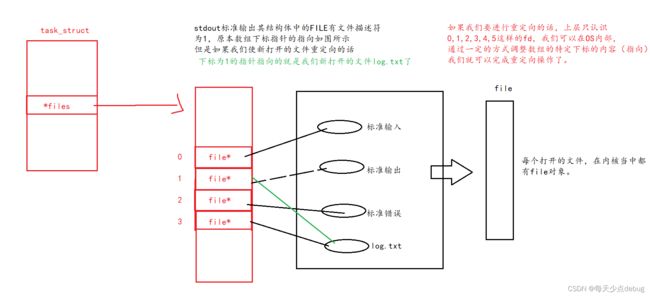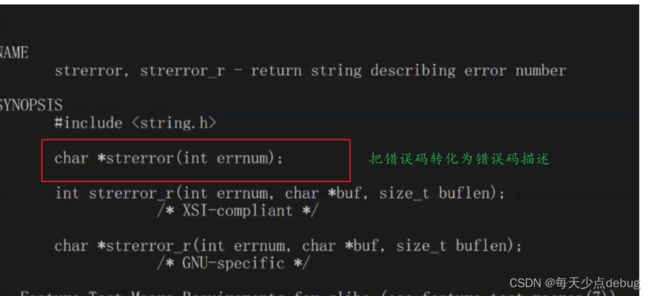(万字长文)Linux——IO之重定向+缓冲区 +重定向 +缓冲区原理实现 +带重定向的简易版shell+标准输出标准错误
索引
- 文件描述符分配规则
-
- 重定向
- 缓冲区
-
-
- 1.什么是缓冲区
- 2.缓冲区在哪里
-
- 重定向
- 源码模拟实现缓冲区原理
- 带重定向的简易版Xshell
- 标准输入和标准错误
文件描述符分配规则
文件描述符的分配规则
从头遍历数组fd_array[],找到一个最小的,没有被使用的下标,分配给新的文件。
int main()
7 {
8 close(0);
9 int fd = open("log.txt", O_WRONLY | O_CREAT | O_TRUNC, 0666);
10 if(fd < 0) {
11 perror("open");
12 return 1;
13 }
14
15
16
17 fprintf(stdout, "打开文件成功, fd : %d\n", fd);//将特定的字符串格式化写到特定的流中
18 close(fd);
19 return 0;
20 }
如上所示,如果我们一开始将文件描述符0关掉,那么此时我们打开"log.txt’系统会为其分配的文件描述符为0

再看一个例子
如果此时我们将fd = 1 关闭,此时1这个文件描述符就会给新的文件log.txt
正常情况下如果我们cat log.txt的时候会打印出内容,因为我们在一开始关闭了显示器的标准stdout,然后再打开log.txt的时候其文件描述符会被自动填充为stdout.
但是运行之后发现

显示不出来,此时如果在源码中加上fflush(stdout)发现就可以cat log.txt就可以打印出来了

这是为什么呢?
先看下面的重定向和缓冲区的理解
重定向

所以也就不难理解追加重定向了,追加重定向就是将打开文件的方式修改一下。

输入从定向,就是dup2(fd, 0)
缓冲区
1.什么是缓冲区
缓冲区的本质:就是一段内存
- 解放使用缓冲区的进程时间
- 缓冲区的存在集中处理数据刷新,减少IO的次数,从而达到提高整机效率的目的
2.缓冲区在哪里
先看一段代码
1 #include<stdio.h>
2 #include<sys/types.h>
3 #include<sys/stat.h>
4 #include<fcntl.h>
5 #include<unistd.h>
6 #include<string.h>
7 int main()
8 {
9 printf("hello printf");//printf默认输出时候的文件描述符是1
W> 10 const char *msg = "hello write";
11 write(1, msg, strlen(msg));//将msg写到标准输入中
12
13 sleep(5);
此时发现先输出hello write 五秒钟之后再输出hello printf
printf("hello printf");//printf默认输出时候的文件描述符是1
10 fprintf(stdout, "hello fprintf");
11 fputs("hello fputs", stdout);
12 const char *msg = "hello write";
13
14 write(1, msg, strlen(msg));//将msg写到标准输入中
15
16 sleep(5);
将代码改成上述发现还是跟原来的现象一样,hello write先打印出来,然后再打印出printf fprintf fputs 的内容
为什么会这样?
可以证明是有缓冲区的,printf和fprintf fputs都是封装了write系统调用接口的,所以缓冲区必然不在write中
发现三个C语言接口的函数都有一个共同点,都有stdout,
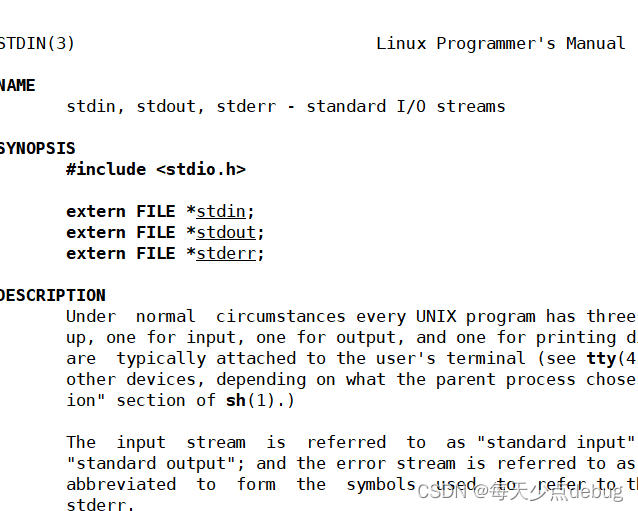
stdout是FILE类型,其是一个结构体,而在结构体中除了有文件描述符外,还有语言级别的缓冲区。

所以缓冲区是语言级别的缓冲区
什么时候刷新?
常规
无缓冲(立即刷新)
行缓冲(逐行刷新,显示器的文件)
全缓冲(缓冲区满刷新)这个对应的是磁盘文件
特殊
进程退出,C语言的强制刷新
用户强制刷新 fflush
重定向
提问:如果在刷新之前,关闭了fd会有什么影响
先看不关闭fd时候的重定向
19 int fd = open("log.txt", O_WRONLY | O_CREAT | O_TRUNC, 0666);
20 if(fd < 0) {
21 perror("open");
22 return 1;
23 }
24 dup2(fd, 1);
25
26 printf("hello printf");//printf默认输出时候的文件描述符是1
27 fprintf(stdout, "hello fprintf");
28 fputs("hello fputs", stdout);
29 const char *msg = "hello write";
30 write(1, msg, strlen(msg));
printf("hello printf");//printf默认输出时候的文件描述符是1
27 fprintf(stdout, "hello fprintf");
28 fputs("hello fputs", stdout);
29 const char *msg = "hello write";
30 write(1, msg, strlen(msg));
31 close(1);

此时发现log.txt中只有write写入的内容,再一次证明了上述我们的结论,调用C语言的文件接口,就是通过fd找到对应的write,如果fd关闭了,就无法再显示了。
现在就可以理解最开始的问题了,如果将标准输出重定向到log.txt,关闭了fd之后就无法刷新了
再看一段代码
const char *str1 = "hello printf\n";
11 const char *str2 = "hello fprintf\n";
12 const char *str3 = "hello fputs\n";
13 const char *str4 = "hello write\n";
W> 14 printf(str1);
W> 15 fprintf(stdout, str2);
16 fputs(str3, stdout);
17 //系统接口
18 write(1, str4, strlen(str4));
19 //调用结束上面的代码,执行fork
20 fork();
上述代码的话,运行后的结果是
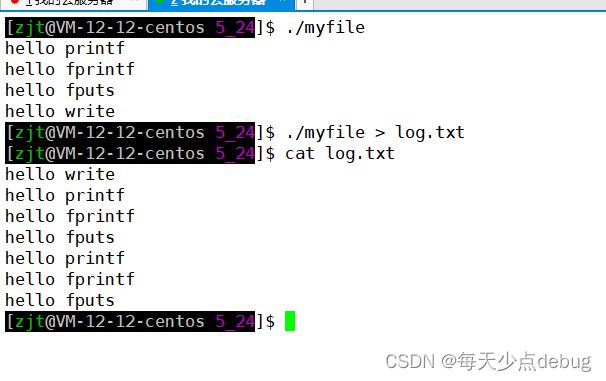
发现添加了重定向之后,此时代码打印是7行,其中C语言接口的函数各打印两条,write无论何种情况都只打印一条,为什么呢?
**代码的最后fork创建了子进程,父子进程代码共享,数据起初也是共享的,因为我们将打印的结果重定向到log.txt了,而log.txt是一个磁盘文件,其刷新的条件是当缓冲区满的时,或者是进程退出的时候,会清空缓冲区,而无论父子进程谁先发生清空,数据都要发生写实拷贝,所以父进程刷新一份数据,子进程刷新一份数据,就是两份数据了,所以才会出现上述情况。
源码模拟实现缓冲区原理
#include最后几行代码如果不加fork()

将fork()注释解除之后

在fork()函数创建子进程之后,此时因为我们的字符串没有\n 所以其是不支持刷新的,fork()创建子进程之后,父子进程代码数据共享,无论父子进程哪个先调用my_fclose(),其都会清空缓冲区,另外一个进程都会发生写实拷贝,所以父进程刷新一份数据,子进程刷新一份数据
带重定向的简易版Xshell
#include 标准输入和标准错误
#include 先看代码,代码运行后的结果如下所示:
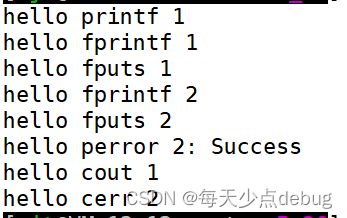
这个没问题,但是当我们将显示结果重定向后

发现并不是所有的显示结果都会重定向到文件中

如果这样操作的话,此时显示结果被分别重定向到了不同的文件中
为什么呢?
因为默认重定向的话只是将fd = 1的stdout重定向到文本文件中,如果需要重定向标准错误的话需要显示的写
所以上述重定向的标准写法应该是这样的
./a.out 1 > stdout.txt 2>stderr.txt
这么做的意义何在呢?
可以区分哪些是程序的日常输出,哪些是错误!
那么能不能将标准输出和标准错误重定向到一个文件中呢?可以,如何做呢?
[外链图片转存失败,源站可能有防盗链机制,建议将图片保存下来直接上传(img-4TGdyG0N-1685098168077)(null)]
可以注意到上述的perror在输出之后还打印出了success 为什么呢?
perror也是一个库函数,这个函数内部会自己获取errno的值,调用这个函数会直接把错误提示符打印出来,此外,我们也可以在错误提示字符串前添加一些自己想要打印的信息
什么是errno?
errno是一个全局变量,记录最近一次C库函数调用失败原因
void my_perror(const char *info)
{
fprintf(stderr," %s: %s \n", info, strerror(errno));
}
int main()
{
int fd = open("log.txt", O_RDONLY);//此时必定是失败的
if(fd < 0)
{
// perror("open");
my_perror("open");
return 1;
}
return 0;
